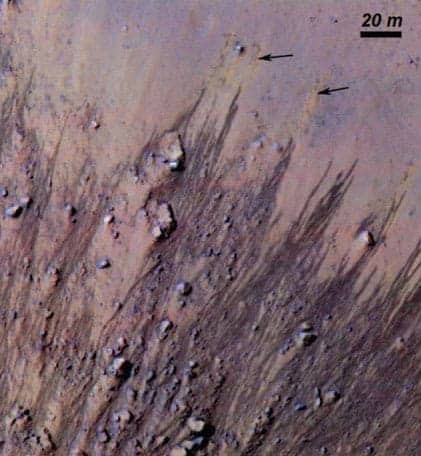
Liquid water might exist on Mars today, according to a group of scientists in the US. Images from NASA’s Mars Reconnaissance Orbiter (MRO) reveal that dark, narrow, finger-like structures follow slopes in certain regions of the southern hemisphere of the planet during its summer months. The researchers believe that these could be caused by flowing salt water and say the finding raises the tantalizing prospect that there might be life on Mars.
In recent years, satellites in orbit around Mars have shown that ice is likely to exist just below the surface of the planet in mid- to high-latitude regions. Satellite images have also revealed gullies on the walls of Martian craters that may have been created by liquid water flowing down the walls in fairly recent geological history – although some researchers do not agree. However, it is widely agreed that liquid water in the form of long-lived lakes could not be present on Mars today, given average surface temperatures on the planet of about –60 °C and extremely dry conditions.
Now, Alfred McEwen of the University of Arizona and colleagues say the Martian surface may be home to liquid water after all, even if in a somewhat transient state. The discovery came after one of McEwen’s colleagues, Lujendra Ojha, analysed two slightly offset images of the same point on the Martian surface taken by the MRO’s telescope, the High-Resolution Imaging Science Experiment (HiRISE). The idea was to construct a stereo image in order to perceive depth, but this proved problematic because the details in the images, which were taken at slightly different times, were not identical.
Changing with the seasons
The researchers quickly identified the presence of dark streaks just a few metres wide and up to several hundred metres long that extended down steep rocky slopes and the lengths of which changed over time. By referring to other archive images, and then confirming their discovery with fresh images from HiRISE, the researchers realized that these features were present in a few select places in the southern hemisphere, and that they appeared in Mars’ late spring, grew during the summer and then faded with the onset of autumn or winter.
Another team member, Shane Byrne, says that the researchers “thought long and hard” about what could be causing these streaks. They wondered whether the culprit might be dust avalanching down the slopes and exposing darker material below, but they ruled out this idea because the phenomenon is only visible on slopes that are practically dust-free. Another possibility is that the streaks are caused by melting ice, but the researchers dismissed this because in some of the regions studied the peak daytime temperature at the height of summer reaches 25 °C, which would prohibit the formation of ice for any length of time.
Instead, say the researchers, the streaks are best explained by flowing briny water. Salt, which is known to be widespread on Mars, lowers the freezing point of water, allowing it to exist in its liquid state at temperatures well below 0 °C. Salt also alters the evaporation properties of water, meaning brine can withstand Mars’ extremely dry conditions more readily than pure water. As for the darkened surfaces, McEwen and colleagues suggest that the liquid might be sticking fine-grained materials together and causing them to appear dark when usually they would be lighter, but the researchers admit that they cannot explain why the slopes return to their normal colour in winter.
Mysterious streaks
There are more unanswered questions regarding the streaks. Why, for example, have none been found in Mars’ northern hemisphere? The team suggests that this could be because of a greater abundance of suitable rocky slopes in the south and the fact that southern summers are warmer. Most importantly, however, the team does not understand where the water comes from. The researchers hypothesize that the water seeps out onto the rocky outcrops having travelled along cracks within the rock until it meets the surface. This suggests that the water is coming from underground, but, as Byrne points out, the temperature just a few metres below the Martian surface, even in the height of summer, is low enough to freeze all but the most exotic brines.
Michael Hecht of NASA’s Jet Propulsion Laboratory in California, who was not involved in the research, believes that the work provides “convincing and exciting” evidence for flowing water on the surface of Mars. He says that McEwen and colleagues are “entirely justified” in pinpointing brine as the explanation, pointing out that Mars is so dry that even at temperatures as low as –70 °C, water can still evaporate. “The only way to have persistent liquid water is to find a way for it to remain liquid near –70 °C,” he says. “Brines can do that.”
Hecht, however, thinks that the water is probably “scavenged” from the atmosphere, explaining that during the winter the steep slopes in the southern hemisphere are colder than any of the surrounding surfaces and so trap water by preventing it from evaporating.
To prove the brine hypothesis, however, a robotic landing craft will need to be sent to one of the regions with the newly identified features, says Byrne. A lander, he says, would be able to positively identify the existence of liquid water and, if it did so, establish the water’s composition to find out what kind of salts it contains. He adds that such a mission might also be able to hunt for signs of simple life forms, suggesting that unusual types of bacteria might conceivably live in brine water.
The research is published in Science 333 740.



